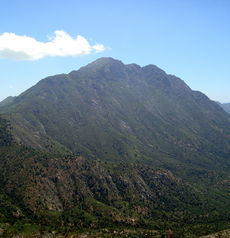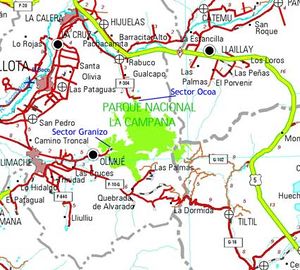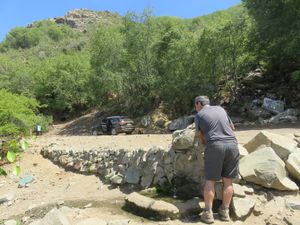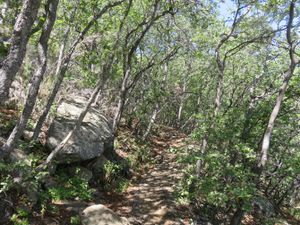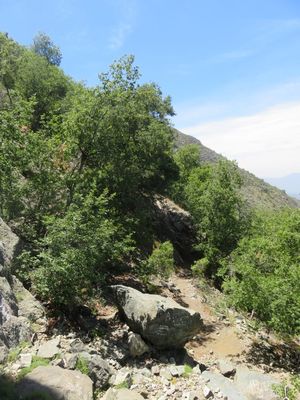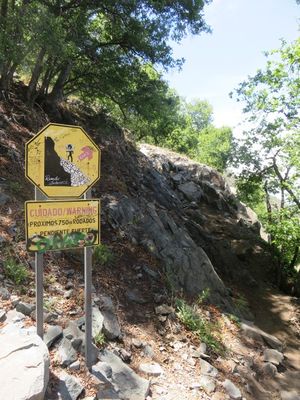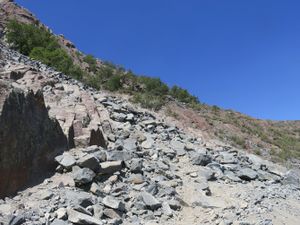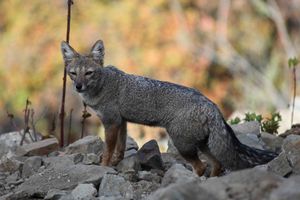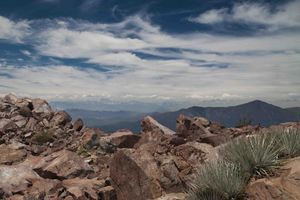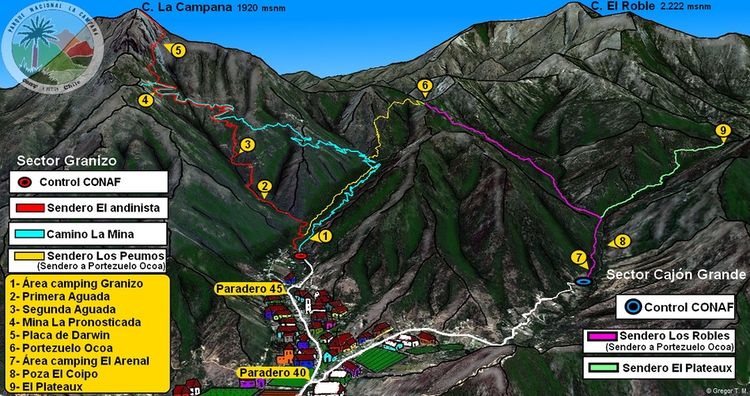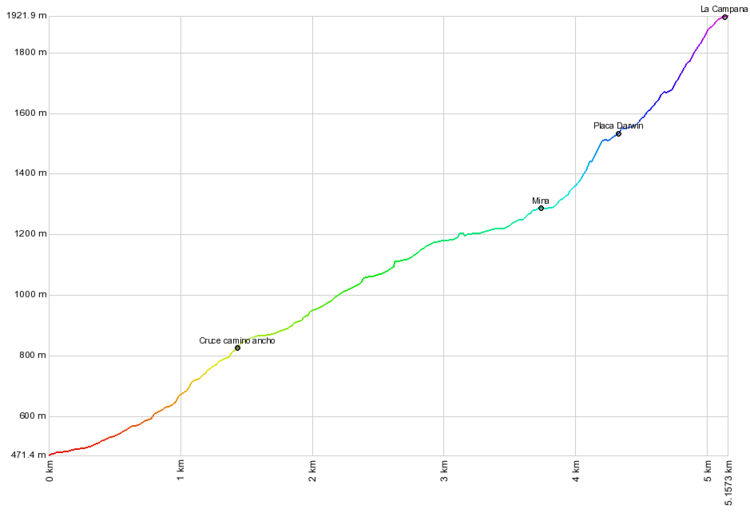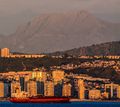ENG:Cerro La Campana

|
|
| |||||||||||||||||||||||||||||||||||||||||||||||||||||||||||||||||||||||||
Attention
Since this route is located inside a National Park, there are rules defined by Conaf that must be respected and known when planning an ascent to the hill. The following is highlighted (updated in October 2017):
- During the months of 'winter the ascent to the summit' is not allowed, but apparently until the sector of the Mine. This would extend between June and September.
- The 'maximum time' to reach the La Mina sector is 12:00 pm. In case of arriving later, it will not be allowed to continue with the ascent to the summit. Depending on the official present at the site, this could be extended until 12:30 pm, but not entrusted.
It is recommended to find out previously because these rules, like everything in life, can change (for better or for worse).
Appropriate time
Ideal autumn, with red oaks, or spring. Full summer is very hot, but possible.
Access
From Viña del Mar or Valparaíso
Through Quilpué and Villa Alemana by the trunk road, of dense traffic, especially in its urban stretch. Leaving Villa Alemana are 22km to Limache. The road to Olmué goes to the right, traveling 8km more to the town. Continuing in the same direction, the park is accessed. Further up (5km) there is a last fork, with the Granizo (left) and Cajón Grande options. The Bell goes up from Hail. From here to the Conaf is the only unpaved section of the route (1km, bad condition).
From the goal of Conaf (approx 400m), the ascent of the mountain normally begins, although with a good all-terrain it is possible to continue climbing much more, even to La Mina (1265m) if the path allows it.
From Santiago
For the Pan-American North. A few kilometers after the toll is the detour to Til-Til (there is a level crossing). From there it is 20km to the village, which is completely crossed. At the end you reach the road that crosses the Cordillera de la Costa through the slope La Dormida. The road is recently paved and widened. At 33km from Til-Til there is the detour towards Olmué, not signposted (it is only indicated "towards motocross"). After crossing the town, you should take the road in the direction of the park, to the east. Further up (5km) there is a last fork, with Granizo and Cajon Grande options. The Bell goes up from Hail. From here to the Conaf is the only unpaved section of the route (1km, bad condition).
From the goal of Conaf (approx 400m), the ascent of the mountain normally begins, although with a good all-terrain it is possible to continue climbing much more, even to La Mina (1265m) if the path allows it.
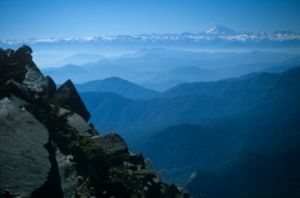
Description of the route
Either through the path that runs through the picnic tables or continuing along the road to La Mina, you will come to a first sign that indicates the "climber's path" and announces 4½ hours to the summit, a conservative time but good reference The road meanders along the southern slope in the middle of a dense forest of acorns, lingues, peumos, boldos, molles, quillayes, litres, pataguas and maquis, among others, surprising with its greenery for latitude; Interestingly, in this sector it rains about 700 mm per year, more than double that in Santiago, which explains this and the oaks above. 20 minutes from the sign is the first aguada (580m), which is the second crossing of the estuary. The road continues winding, always signposted, crossing repeatedly with the vehicular footprint. Above, the first clearings appear and it is possible to contemplate the valley of Olmué. Then we finally go back to see the granite massif that crowns the hill and, at approx. 1h, the second aguada (875m), good place to rest and admire the mass of rock thatwait above, besides being the last place with water before La Mina.
The road in this sector is softer, coinciding a stretch with the vehicular road. The first oaks and isolated peaks of the old quartz miners appear. This leads to La Mina (1265m), where there is an esplanade in the middle of the hillside and a larger pique that can be traveled, for which it is recommended to bring a headlamp (it is still gloomy and wet). The path, always clear, continues in the middle of the northernmost oak forest of America until you reach the foot of the rock tower.
Subsequently, the footprint continues at the foot of the wall, with little slope to the east. Climbing routes (painted roughly on the rock) and then the plaque laid by the British Colony on the occasion of the centenary of the ascension of Darwin (1525m), in August 1834, unfortunately painted by the "immortal cheap". The next section is possibly the only diffuse in a well-marked path: it crosses a carry (there indicated as "the rolled") and then turns to the left (north) to ride to the edge that leads directly to the summit, after 20 minutes of loose rock and scattered trees.
From above, not only is the rocky pyramid of Aconcagua immense: after the Cerro el Roble, neighbor and big brother (2222m), the complete list of the giants of the central Andes are lined up for our contemplation and joy ; behind us, the sea if the weather allows it; and to the left, a rocky peak that in winter is home to condors, astute they, dwellers of one of the most beautiful corners of Chile.
The park indicates that the route portería - La Mina takes 2.5h and La Mina - summit takes 2h, while the descent, by the same route, takes approx. 4h A person relatively used to climbing hills, at a somewhat more intense pace, can go up in 3.5 hours and go down in 3 hours without major difficulties or even less.
Road to La Mina
From the second week of September and until April, it is possible to arrive by car to La Mina, which decreases the time of ascent by approximately half. The use of a 4x4 vehicle is recommended, or at least high, as the road is regular to bad
[https: //www.youtube.com/watch?v=pD3JmcBZsJk | Accelerated video of the complete trip in vehicle]
Charles Darwin in La Campana
On August 17, 1833, along with two guides, the British naturalist Charles Darwin reached the top of the Bell. He wrote of his experience:
|
Rates and schedules of La Campana National Park
In 2016, the entrance fees for La Campana National Park are the following:
- Adults
- National: $ 2,300
- Foreign: $ 4000 (US$ 6.5 as of May 2018)
- In situation of disability: $ 1,200
- Greater than 60 years: $ 1,200
- Children
- National under 6 years: FREE
- National between 6 and 18 years old: $ 1,200
- Foreign: $ 2000 (US$ 3.3 as of May 2018)
- In situation of disability: FREE
The Park operates from 8 am to 6 pm from September to May, and from 9 am to 5 pm from May to August. Telephone +56332441342 / +56332443067
Recommendations
- Checklist: Aunque sepas perfectamente lo que debes llevar, es preferible chequearlo al empacar. Esta ruta ha sido clasificada como Type 1 equipment checklist: low altitude route, without camping, snow or cold.
- In La Mina, there is a water source that remains throughout the year.
- The view of the last section from the second wash can intimidate, but not to be deceived: the hill does not present any technical difficulty for the official path.
- The summit is a great graffiti: please do not continue with that.
External Links
Weather forecast
- Meteochile Region of Valparaíso
- Accuweather Valparaíso
- Accuweather Viña del Mar
- Meteochile Metropolitan Region
- Accuweather Santiago
- Accuweather Puente Alto
Horseback riding in La Campana National Park
To hire horses in the La Campana National Park, it is possible to contact Marco at +56967348561 and +56332271996. Marco Cobra $ 4,000 / hour per horse $ 4000 (US$ 6.5 as of May 2018). In two to three hours you can walk quite well the main forests of palms, and in three to five hours you can reach the waterfall and other points of interest of the park.
Hire guided tours and excursions
- Denomades.com: Tours y trekkings regulares y privados en el Cajón del Maipo y otros destinos. Contacto directo con los mejores operadores locales.
- Contacto: reservas@denomades.com
- Teléfono: +56 229551857
- Facebook: Denomades.com
Image gallery
Nearly complete view of the crossing Caleu - Olmué through the Cord of the Penitents from the summit of Cerro La Campana. December 2016
Cerro La Campana from Cerro El Roble. May 2012
Revisa la lista completa de 621 rutas de trekking y las 345 rutas de montaña en Chile
|
Videos
- Articles translated automatically that need human revision
- Drafts
- KMZconTrack
- Parche Cordillera de la Costa
- Parche Clasicos de Santiago
- Indexada
- Imperdonables
- Rutas
- Routes in english
- Montaña
- Rutas de un día
- Montañas de dificultad Muy Fácil
- Páginas con enlaces rotos a archivos
- Rutas con checklist
- Trekking y Montaña en Chile



